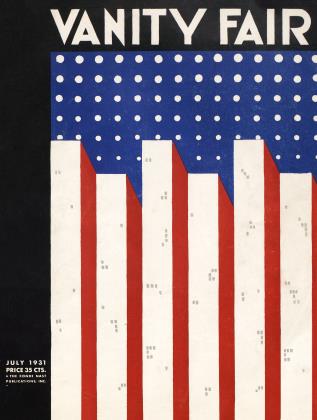Sign In to Your Account
Subscribers have complete access to the archive.
Sign In Not a Subscriber?Join NowThe Editor's Uneasy Chair
Satire a la Russe
Nikolas Remisoff, whose caricature "A Royal Sport" appears on page 23 of this issue, has long been a contributor of sketches, political cartoons and satirical drawings to Vanity Fair. The artist was born of a family of actors of the Russian Imperial Theatre in St. Petersburg, but although he lived in this environment until he was a young man, his ambitions were not of a Thespian character. After receiving his college degree, he entered the Imperial Academy of Arts, from which he graduated with due recognition in the shape of a gold medal.
While still a young man, he took an active part in the founding and editing of a satirical magazine called Satyricon, which played a disturbing role in the political life of pre-War Russia. The Remisoff cartoons were often the subject of in the Duma. After the Bolshevik Revolution, the magazine was forced to discontinue publication, probably because as it was once too radical, it had now, curiously enough, become too conservative, or rather critical, in its attitude of the Revolutionary government. Remisoff was forced to leave Russia, and in Paris, haven of Refugees, he found a field for the continued development of his artistic activities with the Chauve Souris theatre. He followed this merry and original band throughout Europe, and on its successful tour with Balieff, to America. Several undertakings with the Allied Arts in Chicago have kept him since in that city, and although he continues to contribute his forceful drawings to Vanity Fair, the major part of his time is taken in painting portraits and murals in New York and Chicago. ...
Easy to take
The following excerpt is culled from the sacrosanct editorial page of the New York Times, and it was, as the editors of Vanity Fair noted with justifiable pride, entitled A Triumph of Printing:
"For years Americans have been going abroad to learn about color processes and typography. They have been despairingly saying that the Europeans order these things far better, that the most expensive and complicated foreign machinery has, when transplanted, failed to produce the results obtainable on home soil. Part of this was 'defeatist' psythe April issue of Vanity Fair should dissipate this publication inferiority.
"The April issue of Vanity Fair is a distinguished product, both in printing and in color effects. The two-tone portrait reproduction and the four-color printing process have been perfected to a point not passed in Europe or elsewhere. Apart from the format, and from the editorial layout (which has been revised and definitely bettered), Vanity Fair is a delight to the eye of the expert and of the reader. The illustrations in color of circus performers . . . set a highwater-mark in difficult reproduction of art. The clean-cut, readable print has just the strength and delicacy for which the publisher, through experimentation, has been striving."
Tell me, pretty maiden
In the years that closed the Mauve Decade—1901, to be exact—there was let loose upon New York, and the rest of civilization, a lovely menace in the shape of a sextette, known as the Florodora girls. The members of the original sextette rapidly became the rage of the bewhiskcred beaux of Broadway and Gramercy Park, and it was no time before they were inaugurating a Great American tradition in Musical Comedy by marrying themselves left and right to millionaires, and English dukes. There were of course, numerous "Florodora sextettes" rampant in road-companies and revivals, but in pulchritude and they could never hold a parasol to the original ladies, who were, to quote their own words, "pretty maids, and proper, too." It is to be hoped that the pretty, and proper (autres temps, autres mocurs) maidens chosen in the Vanity Fair Beauty Contest (quickly see pages 54-55) will fare as well, go as far, and be remembered by the youngsters of our own generation as long as the Florodora girls, the mention of whom brings a great sigh, and a reminiscent tear to the eye of every oldster over fifty who still lopes down the musical comedy aisles to his front row seat, in the vain hope of seeing a repetition of this beautiful, six-petaled flower of delight.
Bon vivant
Charles G. Shaw, the author of Europe at Table, which appears on pages 60-61 of this issue, has been known for years as the "BrillatSavarin" of America. His articles on the famous plats, the restaurants, cafes and night haunts of all the European capitals have long appeared in the New Yorker, Vanity Fair, Spur, the Bookman and Harper's Bazaar. He is also a serious novelist and has published, among other tomes, Heart in a Hurricane, and The Low-Down, the latter being a group of pen portraits of contemporary personalities. Someone once said Mr. Shaw's pockets if emptied, would reveal much of his life's philosophy: they are always stuffed with steamer tickets, coat-checks, stubs of first-night seats on the aisle, invitations, hastily jotted notes, and bits of sketch paper, for the genial bachelor is also an artist and caricaturist in his spare moments.
 View Full Issue
View Full Issue






Subscribers have complete access to the archive.
Sign In Not a Subscriber?Join Now